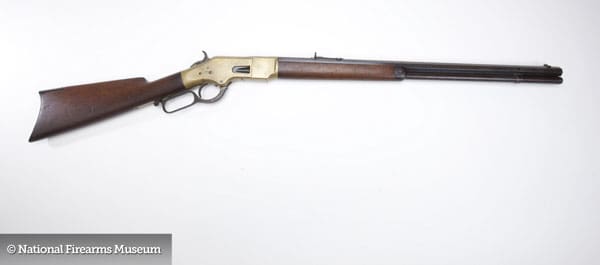
Unless you’re a lifelong student of them, it can be hard to keep all of the details of the Winchester lever-action rifles straight. So, here’s a “cheat sheet” of important facts and figures. It’s by no means comprehensive, but it’ll make sure you don’t confuse a Model 1876 with a Model 1894!
In addition to the information below, a good visual reference for the different models is the shape of their loading gate (with the exception of the Model 1895, which is completely different). Take a look at the photos to see what I mean.
WINCHESTER MODEL 1866 LEVER-ACTION (above)
Approx. 170,000 made, 1866-1898. The first gun made under the Winchester name, the 1866 introduced a loading gate on the sideplate. Because of its distinctive brass frame, it was called the “Yellow Boy” on the American frontier.
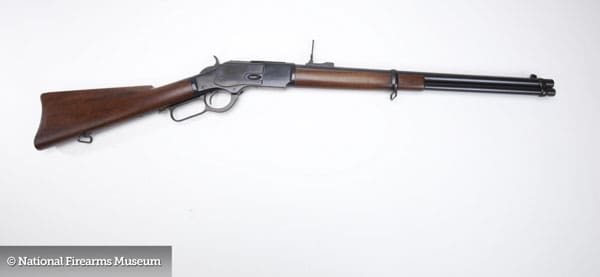
WINCHESTER MODEL 1873 LEVER-ACTION
Approx. 720,000 made, 1873-1919. It was sometimes called “The Gun That Won the West” and was the first Winchester to use centerfire cartridges and to have an iron frame with a removable sideplate. Standard configurations included the 20” round barrel carbine, 24” octagon or round barrel rifle, and the 30” round barrel musket. Standard chamberings included .44-40 (.44 WCF), .38-40 (.38 WCF), and .32-20 (.32 WCF). Between 1884 and 1904, .22 rimfire was an additional available caliber.
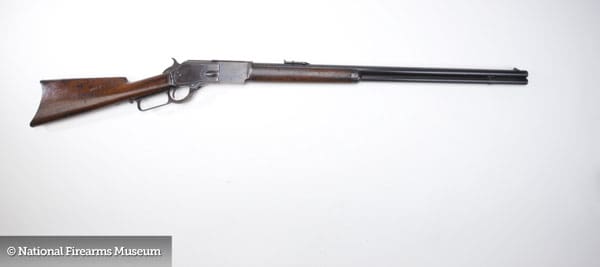
WINCHESTER MODEL 1876 LEVER-ACTION
Approx. 63,800 made, 1876-1897. A bigger version of the Model 1873, it features a larger and stronger receiver to fire rifle cartridges like the .45-77 WCF, .50-95 Express, .45-60 WCF, and .40-60 WCF. It was also the first Winchester model to offer a pistol grip style buttstock.
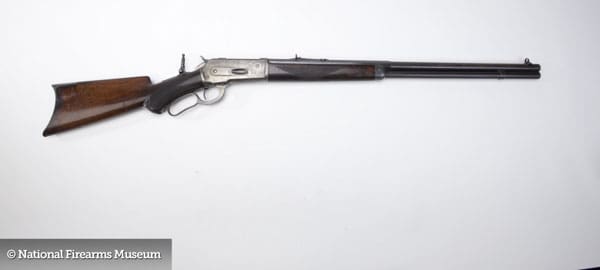
WINCHESTER MODEL 1886 LEVER-ACTION
Approx. 160,000 made, 1886-1935. This model was capable of firing more powerful cartridges suitable for big game, such as .45-70, .45-90, and .50-110, making it popular with hunters in the American West. Lightweight takedown versions were also available for this model.

WINCHESTER MODEL 1892 LEVER-ACTION
Approx. 1,000,000 made, 1892-1945. Essentially a scaled down version of the Model 1886, the Model 1892 was the first Winchester designed for smokeless powder. It was chambered for the same lower-powered cartridges as the Model 1873, plus .25-20, with the .44-40 cartridge being the most popular chambering. The ability to fire 5-IN-1 Blanks made it popular in western TV shows and movies, such as True Grit and The Rifleman.
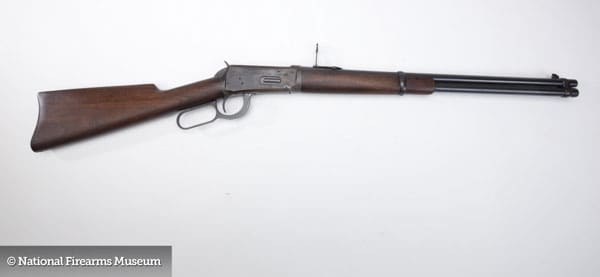
WINCHESTER MODEL 1894 LEVER-ACTION
Approx. 7,000,000 made, 1894-2006. More than 80% of all Model 1894s are chambered for the .30-30 cartridge. The combination of the Model ’94 and the .30-30 became the quintessential American deer rifle during much of the 20th century. This made the Model 1894 the first commercial sporting rifle to sell more than seven million units.
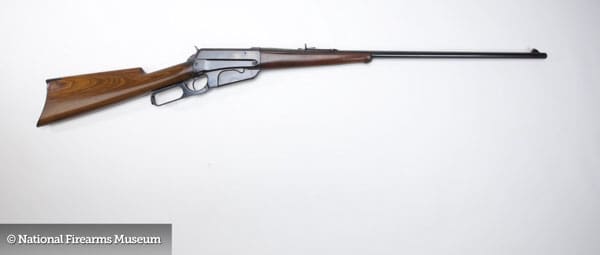
WINCHESTER MODEL 1895 LEVER-ACTION
Approx 425,000 made, 1895-1940. The Model 1895 was the first Winchester rifle to incorporate a box magazine below the action that was designed to accept high-powdered spitzer cartridges. They were loaded on top of one another instead of tip-to-primer in a tubular magazine, as used on previous models. This made it possible to load the pointed spitzer bullets into a Winchester lever-action rifle without worry of accidental primer detonation.
Logan Metesh is a firearms historian and consultant who runs High Caliber History LLC. Click here for a free 3-page download with tips about caring for your antique and collectible firearms.




Nice! I love leverguns. And I love these historical posts. I’ve started doing historical research for an old-west themed RPG I’m building, and the array of firearms, cartridges and calibers is dizzying. This is a great starting point.
Awesome! Best of luck with that project.
Thanks. 🙂 It’s a lot of fun and also a lot more time-consuming than I expected. I have this vision of releasing it as an indie game (with the vast riches that entails), but it feels like the world as we know it might end before I’m done.
Awesome article! Needs moar Henry, Model 71, and Model 88 though.
I’ve got one of those 88s, a beautiful 1955 model in .243 but the firing pin breaks basically every time it take it out of my safe
I’m surprised there’s no mention that most of the 1895s were made in 7.62x54r for WW1 Russian contracts.
I am a big fan of those “high-powdered spitzer cartridges.”
I recently acquired my first lever gun, a used Winchester Model 92 in .45 Colt, not an original cartridge, but it matches an 1873 I have. I haven’t gotten out to shoot it yet, but my son did and says it is a lot of fun.
Nice post!
1866 4th generation was not only chambered for the .44 rimfire, it was also available for the .44-40 (Win 44 center fire or .44WCF)
I enjoyed reading the informative article and it is a good refresher even for us old Winchester disciples
The 1892 sticks out as the smoothest operating lever gun, bar none. It is so underrated nowdays but with an action that feels like it runs on glass bearings, it brings smiles to the user like none other. I have one of the new ones in .44 mag and love it!
I bought a 1975, New Haven manufactured Winchester ’94 in .30-30 Win a couple of months ago. It hadn’t fired more than a couple of boxes of ammo in all those years. It is one sweet lever gun.
Old Winchesters in excellent condition are hard to find at a decent price. Many of them were hunted hard, and older models in top condition are highly collectible and expensive.
New Winchester lever guns are made mostly by Miroku in Japan. Miroku is a good manufacturer, but c’mon. A Japanese rifle that won the West? I don’t think so.
Due to the “anti” attitude in New Haven after years of fighting with the union laborers who failed to see the decline in volume at Winchester, the plant was closed in 2006(?). Quality declines there were quite evident in the final years, in spite of FN’s investments in facilities and upgrades.
Basic issues, such as declines in lever action sales numbers (Not just Winchester, across the board) made it impractical to invest in a new plant to make such specialty firearms, such as the 1886, 1892 and 1895, so say nothing of the “Gun That Won the West” ; the 1873. Miroku had already made such an investment at Browning’s behest, so looking there seemed logical.
Do I like that a new 1894 is rollmarked with the Miroku name as well? Hell no ! It disappoints me badly. but I am very glad that we still can buy a new 1892, ’94 etc at all! The new lever guns have exceptional quality, something the last New Haven guns were sorely lacking. Do I want that the “Gun That Won The West is made in the far East? Not so much, but it certainly beats not having the choice at all.
Just think about it as an awesome alternate reality. Besides, the magnificent 7 was a ripoff of 7 samurai- yet both were great films. It’s only fair that the Japanese can give back to American culture.
To be honest, I’m the guns 2.0 generation, and I thought lever actions were stupid and outdated, and anyone with half a brain should be using a semi auto in place of a lever action, even after watching Firefly, and other films trying to bring them back.
However, I’m raptly watching Westworld, and I’m starting to appreciate lever actions.
Shoot one, they are just plain fun. My hand is a little sore from about 250 rounds through my Henry Frontier in 22 and about another 100 through my Uberti 1873 in 357. Just got back from taking my son to his first range trip. Old man and young boy both had a great time.
I disagree. Look at:
http://dailycaller.com/2013/11/30/the-winchester-model-88-bolt-action-rifle-with-a-lever/
Sincerely, Sharice
Interesting article, very informative.
I have seen a couple of these stamped .30 caliber do they still make ammunition for them
Comments are closed.